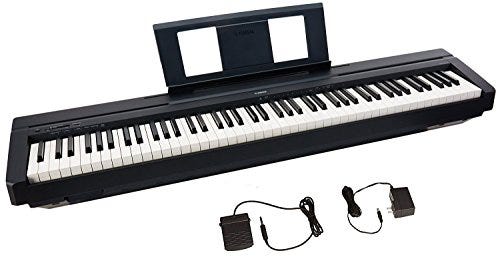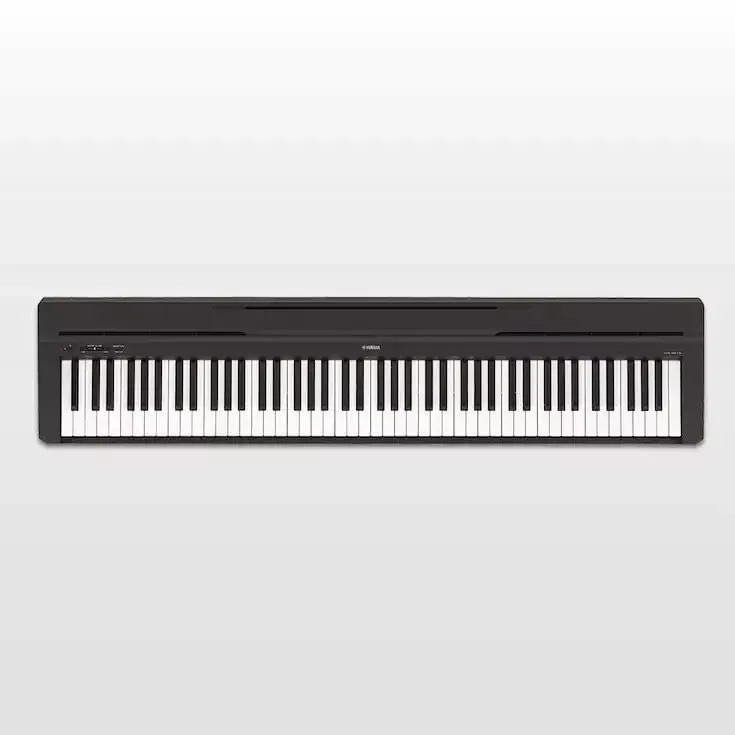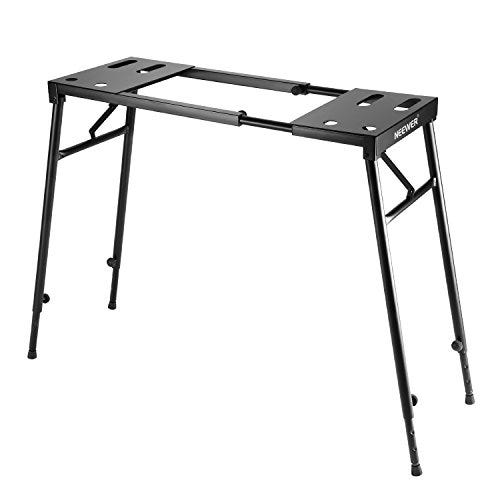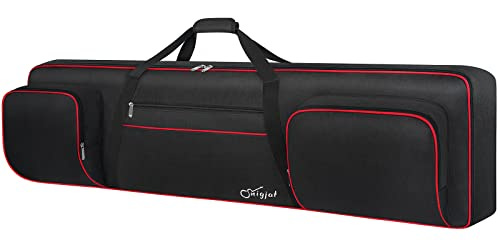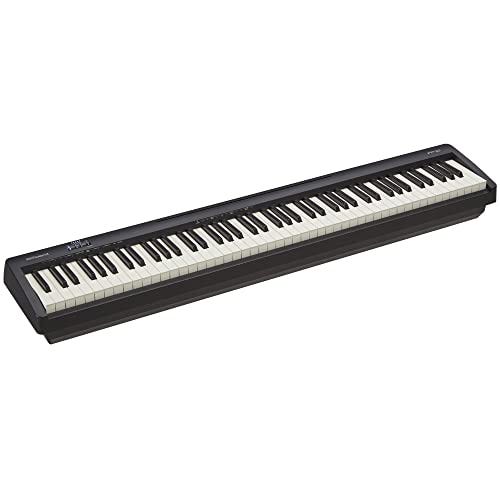Yamaha P45 Full Review: The Best Beginner Piano In 2024?
Digital Piano Reviews, Stage PIano Reviews
The Yamaha P45 is a compact stage piano that has gained popularity among beginners and professionals alike. With its authentic feel, superior sound quality, and Yamaha’s renowned build quality, the P45 stands out in the market.
In this article, we will explore the key aspects of the Yamaha P45, including its design, performance, sound quality, and portability.
We’ll delve into its features, benefits, and potential drawbacks, providing you with a comprehensive review of this digital piano.
Yamaha P45 Full Review: The Best Beginner Piano In 2024?
Contents [show]
Overview
The Yamaha P45 is designed to be the perfect home digital piano for rehearsing, learning, and creating.
It’s a full-sized piano keyboard with fully weighted keys, providing the user with the most realistic feel and sound possible while maintaining a modest footprint in your home.
Design and Build Quality
The Yamaha P45 features a compact and lightweight design that is inherited from its predecessor, the P35.
The Yamaha P45 also boasts a robust body that can withstand the stress of gigging, making it a reliable choice for musicians who frequently perform on stage.
The quality of the keys is comparable to more expensive offerings from Yamaha, although the white keys may feel overly smooth for some players who are used to acoustic and grand pianos.
Its dimensions of 52.2 inches width, 11.6 inches depth, and 6 inches height make it suitable for smaller spaces, while its weight of only 25 lbs makes it easy to carry around
The graded element of the key action is subtle but important. This feature, which weights the low notes slightly differently from the higher ones, mimics the behavior of an acoustic piano and contributes to a more authentic playing experience
The piano’s sleek and black appearance adds a touch of elegance to any setting.
Key Action
The P45 comes equipped with an 88-key fully weighted keyboard using Yamaha’s Graded Hammer Standard (GHS) action. This keyboard provides an authentic playing experience by simulating the feel of an acoustic piano.
The keys are weighted, with a heavier touch on the low notes and a lighter touch on the high notes, mimicking the responsiveness of a traditional piano keyboard. The keyboard’s matte finish ensures a comfortable grip and prevents fingers from slipping, even during intense playing sessions.
You can adjust the level of touch sensitivity to better suit your playing style. There are 4 preset settings to choose from including Fixed, Soft, Medium (default), and Hard.
Sound Quality and Performance
There are 10 instrument sounds available on the P45:
2 Grand pianos (Concert, Bright)
2 Electric pianos
2 Pipe organs
2 Harpsichords
Strings
Vibraphone
The Yamaha P45 offers impressive sound quality, thanks to its Advanced Wave Memory (AWM) stereo sampling technology. This technology accurately captures the sound of an acoustic piano, resulting in a rich and realistic tone.
The P-45 comes loaded with ten voices, focusing on quality rather than quantity. The built-in speakers do a good job of reproducing the low frequencies found on a piano and are more than loud enough for home practice.
It features an authentic grand piano sound, which is highly regarded by musicians and offers a pleasing playing experience.
With 64-note polyphony, this digital piano allows for a realistic piano-playing experience without the worry of dropped notes.
While other digital pianos offer higher polyphony; unless you are playing extremely complex passages, or layering several instruments together at once (which the P45 cannot do as an entry-level instrument), then it is not necessary.
The built-in speakers deliver a rich and immersive sound experience and the headphone output allows for private practice sessions, ensuring you can play anytime without disturbing others
Yamaha P45: Pros and Cons
Pros
The P45 also offers optional accessories, such as a keyboard stand or the L85 furniture stand, to enhance stability and aesthetics during performances.
Portability is one of the key advantages of the Yamaha P45. Its compact and lightweight design makes it easy to transport, fitting into most cars and suitable for on-the-go musicians.
Whether you’re attending piano lessons, jam sessions, or gigs, the P45’s 11.5 kg weight ensures hassle-free mobility.
Affordable price point
Authentic piano feel with GHS action
Impressive sound quality and grand piano sound
Compact and lightweight design for portability
Built-in speakers and headphone output for versatile playing options
Cons
The sustain pedal may need upgrading
L-85 stand not included
Piano Stand
There are several piano stands available that would fit the bill for the Yamaha p45. Whilst single ‘X stands’ are usable for digital pianos, I always recommend double-tier X stands as in my experience they are far more durable and last longer.
It’s normally the mechanism in the middle on single X stands that eventually wears out rendering the stand useless. One step up from the dual X stands is a table-top design stand where the piano is even more sturdy and the stand is even more durable.
Best Digital Piano Headphones
For home practice, the speakers may suffice for you, though if you want to truly get lost in the music you play, (and hear the onboard sounds in higher fidelity), then some good quality headphones are a good idea.
You can choose to spend a lot on headphones, getting something that would be useful for music production and entertainment as well (Sony XM headphones). However, you could also opt for a budget pair just for piano practice, such as these:
More: for the best digital piano headphone options, check out the following article:
The Best Headphones for Practicing Piano in 2023
Piano Case
Various cases and bags are available for the Yamaha P45. One option for each has been handpicked below:
Yamaha P45 Comparisons
Yamaha P45 vs. P71
There is an Amazon-exclusive version of the Yamaha P45, which is named P71. They are 100% identical.
Yamaha P45 vs. P125
When it comes to entry-level digital pianos, Yamaha’s P45 and P125 are two options that often come to mind.
Both pianos are portable, featuring full-sized 88-note weighted key hammer actions and convincing piano sound quality. However, there are significant differences between the two that can influence a buyer’s decision.
The Yamaha P45 is a good choice for beginner players, but it’s quite basic in its features. It has 64-note polyphony, 10 sound presets, and 20 included songs. Its speakers are decent but not great, and it lacks the ability to connect to a PC.
On the other hand, the Yamaha P125 is great for beginner to intermediate players. It offers more features, including 192-note polyphony, 24 instrument sounds, and 50 preset piano pieces.
The P125 also has better speakers than the P45 and can be connected to a PC. It’s more expensive than the P45, but the additional features and superior sound quality make it worth the extra cost.
In terms of sound quality, the P125 stands out. It includes Yamaha’s Damper Resonance and Intelligent Acoustic Control technology that lends itself to a much more natural and expressive playing experience.
Choosing between the Yamaha P45 and P125 ultimately depends on your needs as a pianist and your budget. If you’re a beginner looking for a basic, affordable digital piano, the P45 could serve you well.
However, if you’re willing to invest a bit more for superior sound quality and additional features, the P125 is the clear winner.
Yamaha P45 vs. Roland FP10
Another competitor at this price point for beginner digital pianos is the Roland FP-10. The Roland FP10 slightly edges out the Yamaha P45 in terms of features and performance.
The FP10 is equipped with Progressive Hammer Action, which provides a realistic feel similar to an acoustic piano, and its keys are coated with a material that mimics the texture of ivory and ebony.
The FP-10’s PHA IV action is highly regarded due to its realistic ‘action’, which is comparable to an acoustic piano thanks to its weighty feel and escapement. The FP-10 continues to be a solid choice for beginners.
In terms of sound, the Roland FP10 is also praised for its tones, which are enhanced by Roland’s top-notch ‘supernatural engine’.
Despite their differences, the choice between the two often comes down to personal preference, as both pianos offer high-quality sound and a realistic playing experience.
The Yamaha can usually be found slightly cheaper, but prices do fluctuate for both instruments.
FAQ
1. What Are the Key Features?
It has an 88-key Graded Hammer Standard (GHS) keyboard, which provides an authentic piano-playing experience. The feel of the keyboard gradually changes according to the register, so that it feels heavier when playing bass parts and lighter when playing treble parts.
The piano also features a keyboard with a natural feel, with black keys that feature a matte finish for authentic piano playing close to that of an acoustic piano
Advanced Wave Memory (AWM) Stereo Sampling for realistic piano sounds.
Compact and lightweight design for easy transportation.
Simple operation with a single button for changing various settings.
2. Who Is It Most Suitable For?
The Yamaha P45 is most suitable for beginners and intermediate players due to its simplicity, attractive price, and high-quality and realistic sound of Yamaha instruments.
3. How Does It Compare to Other Digital Pianos in the Same Price Range?
The Yamaha P45 is the most affordable digital piano with fully weighted hammer-action keys in Yamaha’s arsenal, making it a competitive choice in its price range.
4. What Is the Weight and Size? Is It Portable?
The Yamaha P45 weighs 11.5kg (25lbs., 4oz) and measures 1,326mm (52-1/4”) in width, 154mm (6.0”) in height, and 295mm (11-1/2”) in depth. Its compact and light design makes it highly portable.
5. What Accessories Are Included?
The Yamaha P45 includes a music rest, a pedal/footswitch, and an AC adaptor (PA-150 or other Yamaha-preferred parts). Yamaha offers optional accessories for the P45, such as a keyboard stand or the L85 furniture stand, to enhance stability and aesthetics.
6. Does the Yamaha P45 Have a Headphone Jack?
Yes, the Yamaha P45 does have a standard headphone jack for private practice.
7. Can you Connect It to a Computer for Recording and Production?
Yes, the Yamaha P45 features a USB-to-Host connection, allowing you to connect it to a computer for music production and for use as a Midi Piano/Controller.
8. Does It Sustain Pedal?
Yes, the Yamaha P45 comes with a basic sustain pedal. However, some users may prefer to upgrade to a higher-quality sustain pedal.
Conclusion
In summary, the Yamaha P-45 is a high-quality, versatile, and affordable digital piano that provides an authentic piano-playing experience.
It is a great investment for anyone looking to learn or grow as a musician and pianist, and an excellent beginner digital piano.






